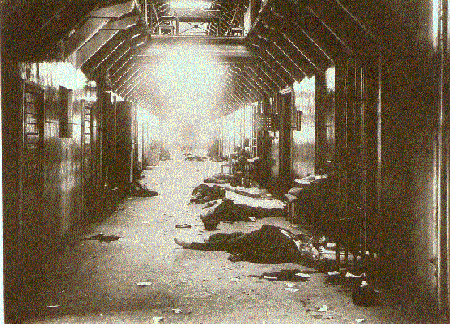


What the acts of violence in 1918 are called – murders, executions – depends greatly on what personal feelings people had about the war in general. The terms "red terrorism" and "white terrorism" reflect the oppressive atmosphere, created by the acts of violence among those population groups against whom the activities were targeted. There were approximately 1,700 victims of red terrorism and 8,400 victims of white terrorism.
Red terrorism was an outburst, which had its roots in the idea of revolution for which the Russians had set an example. Revolution implied sudden change, abolition and suppression of the old order in a situation where the ordinary laws were not considered valid. Red terrorism had two climaxes. In three weeks’ time after the outbreak of the rebellion, the amount of violence was continually on the increase, but by mid-February, it was petering out considerably. The revolutionary leaders made efforts to prevent these illegalities from getting out of hand. The People’s Delegation, who throughout the war had struggled against the line of action supporting stronger military dictatorship, tried, through proclamations, to appeal to the red guards to end the terrorism. The second wave of red terrorism came about in April. The entire western army of the reds began a rapid retreat, burning and destroying houses and even grain stocks. The idea was "to get even" before the retreat.
The main reason for white terrorism was the hatred, horror and revenge mentality born out of red terrorism. Those who took part in it, in some strange way, felt their actions were justified, because they were directed towards individuals who had rebelled against the legitimate government, robbed and murdered, and were guilty of high treason, having entered into alliance with the Russians. Thus, the law of severe punishment was motivated by various outlooks. In some cases, the motivation may have been personal revenge rising out of long-standing feelings of grudge against someone or some other event connected with the rebellion.
It was commonly thought that there was no need to stick to formalities, in case someone was caught trespassing in the military area. As the white troops did not, at the first stages of the war, have distinctive instructions of how to deal with the reds, Mannerheim ordered, in a proclamation issued on the 27th of February and drafted by the advisory committee, that anyone who was caught, behind the back of the army, destroying roads, bridges, vehicles, or telegraph and telephone wires, anyone who resisted the legal military forces or was caught possessing illegal weapons, as well as all snipers and arsonists, were "to be shot on the spot". At the same time, he forbade the establishment of field courts martial. Mannerheim made efforts to supervise these instructions throughout the war, but the broad interpretations of the term "to be shot on the spot" opened a way to illegal executions or so-called white terrorism.
The extent of white terrorism increased gradually but steadily. Up to mid-March it was, generally speaking, fairly insignificant, most of it (two thirds) concentrating in one particular location, Varkaus, during the first month of the war. The executions of the prisoners increased in number after the offensive operations were started, and, in the course of the spring – from March to May – Mannerheim had to intervene on several occasions. But Mannerheim did not get his own way immediately. White terrorism did not die down with the end of the war. During the four weeks after the end of war activities (beginning on 5 May), at least 3,100 reds were killed, which constitutes as much as 37 percent of the extent of all white terrorism. Most of these killings took place at arrestation or by decisions of field courts martial.
Commander-in-Chief 1918 | Headquarters 1918
| Vaasa Senate | Hannes Ignatius
| Martin Wetzer | Harald Hjalmarson
| Ernst Linder | Gösta Theslöf | Jägers | St Petersburg Question | Relations with Germany | Cross of Liberty
| Eastern Karelia | Uusimaa Dragoon
Regiment | Fir Twig | Finnish Flag
| Swedish Brigade | Civil Guards | Jäger Conflict | Heikki Kekoni | Red Prisoners | Wilhelm Thesleff
| Aarne Sihvo | Rudolf Walden |
Air Force - Air Weapon | Red and White
Terrorism | Great Parade 16 May, 1918 | Åland Question | Monarchy | Mannerheim's Resignation
COURSE OF LIFE | FAMILY | TIME OF GROWTH | MILITARY CAREER | WAR OF INDEPENDENCE | REGENT 1918-1919 | CIVILIAN | DEFENCE COUNCIL | COMMANDER-IN-CHIEF 1939-1946 | PRESIDENT OF THE REPUBLIC 1944-1946 | RETIREMENT | SPECIAL TOPICS | SEARCH